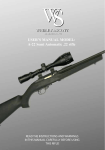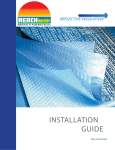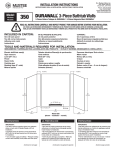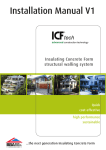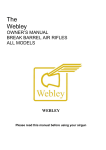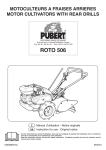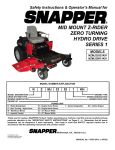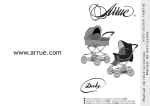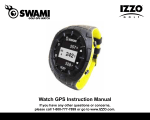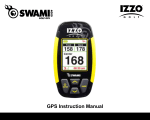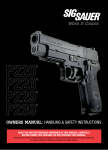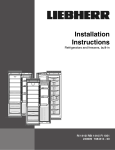Download USER MANUAL - Webley and Scott
Transcript
WEBLEY & SCOTT EMPIRE USER MANUAL READ CAREFULLY BEFORE USING THIS FIREARM EMPIRE RIFLES IMPORTANT! Do not discard! Keep this manual with your rifle. It should accompany the rifle to any new owner. www.webley.co.uk NOMENCLATURE Ref.No. 1. 2. 3. 4. 5. 6. 7. 8. 9. 10. 11. 12. 13. 14. 15. Muzzle Barrel Magazine release Magazine Trigger guard Trigger Stock Sling swivel stud Heel pad Bolt handle Cocking indicator Bolt sleeve Bolt Receiver Safety lever Ref.No. 16. Red dot indicator 17. Bolt release 18. Chamber end of barrel (inside stock) Important terms you should be familiar with: Bore: The hole through which the bullet passes. Chamber: The enlarged rear portion of the bore into which a cartridge is seated for firing. Muzzle: The front face of the barrel from which the bullet emerges. The Ref.No. appears in brackets next to the part descriptions throughout this manual, to help with part identification. TECHNICAL SPECIFICATIONS Barrel length Overall length Rate of twist .204 Ruger 22” 42” 1-12” .223 Rem 22” 42” 1-12” .22 - 250 Rem 22” 42” 1-14” .244 Win 22” 42” 1-10” .308 Win 22” 42” 1-12” 7mm - 08 22” 42” 1-9.5” .25 - 06 22” 42.5” 1-10” .270 Win 22” 42.5” 1-10” .30 - 06 22” 42.5” 1-10” .300 Win mag 22” 42.5” 1-10” .338 Win mag 22” 42.5” 1-10” 7mm Rem 22” 42.5” 1-9.5” 6.5 x 550 22” 42.5” 1-8” Calibre (Inches) (Inches) (Twist per inches) Short Action Long Action BEFORE USING YOUR RIFLE You must first learn how to CLEAR your rifle. The Webley & Scott Empire is considered CLEAR when there is no ammunition in the chamber or in the magazine, the bolt is open and the safety in the fully rearward ‘ON’ position (see position 3 and Figure 6 USE OF THE THREE POSITION SAFETY) To clear the rifle: Holding the rifle with the base of the magazine parallel to the floor and with the muzzle Figure 2 pointing in a safe direction, remove the magazine by moving the magazine release button to open (see Figure 2) Ensure you cup your hand underneath the magazine to catch it as there no retention when the magazine relief has been pressed. Ensuring that you are still pointing the muzzle of your rifle in a safe direction, pull the bolt fully to the rear. This should eject any cartridge that may be present in the chamber. Leave the bolt open and put the safety to the fully reaward ‘ON’ position (see position 3 and Figure 6 USE OF THE THREE POSITION SAFETY). Always clear your rifle before handing it to another person. If someone hands a firearm to you, determine for yourself whether it is clear before any further handling. Never assume any firearm is unloaded and do not accept anyone’s Figure 3 assurance that a rifle is unloaded. Look inside it yourself. When entering or leaving a range or hunting area, or when showing the rifle to others, make sure the bolt is open, the safety is ‘ON’ (see position 3 and Figure 6 USE OF THE THREE POSITION SAFETY). and all ammunition has been removed. By this method others can see, without need to operate its mechanism that the rifle is clear. You should note that in certain countries, such as the UK, a rifle is legally considered still loaded even if the magazine has been removed if the magazine still contains live rounds and is on the rifle carrier’s person. Accidents are usually the fault of the handler of a firearm. A rifle is just a machine and it responds to your actions whether these are safe or foolhardy. Of course it has mechanical safety features, but none as effective as the adherence to safe procedures by a cautious attentive handler who never forgets that a single moment’s carelessness can produce a permanent tragedy. TRAINING IS ESSENTIAL The safe handling of a firearm requires specialised training, knowledge and discipline. The best way to learn is with supervised instruction, often available from gun shops, gun clubs, state or countrywide hunting safety programs or in some countries, police departments. For help in finding a training course: United Kingdom: National Rifle Association, Bisley, Brookwood, Surrey, GU24 0PB Tel: 01483 797777 www.nra.org.uk ; USA: National Rifle Association, 11250 Waples Mill Road, Fairfax, Virginia, 22030 www.nra.org RIFLES ARE NOT ALL THE SAME Many makes and models of firearms might look nearly the same. However, they differ widely in design operation and in the location and function of various controls. Study this manual. Thoroughly educate yourself on the characteristics and operation of the Webley & Scott Empire before attempting to load it. Do not permit others to have access to your rifle and ensure you store it securely to avoid untrained, unlicensed and unauthorised persons, especially children, from attempting to use your rifle. Locked storage is recommended and, indeed, in many countries it is required by law. Locked storage of the bolt separately provides additional security. THESE WARNINGS ARE IMPORTANT Firearms, by their nature and intended function, are lethal weapons. By understanding the dangers inherent in the use of any firearm, and by taking proper precautions, you can enjoy complete safety in the use of your firearm. Failure to do so and failure to heed the warnings in this manual may result in accidental death or serious injury to you or others, as well as severe damage to the firearm or other property. NOT JUST FOR BEGINNERS Even if you are familiar with other firearms, do not assume there is no need to study this manual. Accidents happen to experienced shots as well as beginners. Most of them could have been avoided if the shooter had read and followed the instructions in the gun’s manual and had observed the basic rules of gun safety. IT IS YOUR RESPONSIBILITY Having a firearm in your possession is like being the captain of a ship: it is a serious responsibility and yours alone. It is up to you to know how to keep and use your firearm safely, and up to you to always take the necessary precautions, all of them. If you fail to do so and someone is hurt, the blame is yours alone. SAVE YOUR EYES AND EARS Always wear protective shooting glasses and ear plugs or earmuff type protectors whenever you are shooting. Your vision and hearing are priceless and irreplaceable. Always make certain that persons close to you are similarly protected. Shooting glasses will help protect your eyes from burns and abrasions caused by powder gas, metallic particles, burning powder grains, lubricant and similar debris that can emanate from any firearm in normal use. If something goes seriously wrong and fragments of cartridge case or firearm are sent flying, shooting glasses can make the difference between future sight and blindness. The best compromise between protection and convenience is offered by high-quality shooting glasses or industrial-grade safety glasses with large-area shatter-resistant polycarbonate lenses at least 2mm thick. Without ear protection, repeated exposure to shooting noise may lead to cumulative, permanent hearing loss. Many experienced shots who value their hearing wear both ear plugs and ear muffs. At a shooting range it is common courtesy not to commence firing until everyone nearby has their eyes and ears covered. USE OF THE SAFETY RULES TO REMEMBER ABOUT A SAFETY Never depend on a mechanical safety. It is not a substitute for proper gun handling. Like all mechanical devices the safety is subject to breakage or malfunction and can be defeated by wear, abuse, dirt, corrosion, incorrect assembly of the firearm, improper adjustment or repair, or lack of maintenance. No mechanical safety is ‘Childproof’ or ‘fool proof’. No safety ever invented can be relied upon to prevent an accidental shooting by a determined child or foolhardy adult ‘playing’ with a gun. However, you can take and should take precautions to secure your firearm from unauthorised handling. Treat every firearm as if you expect its mechanical safety to fail. You will be astounded at how cautious you become and how little tolerance you will have for the complacency of others. Be muzzle-aware. Always be aware of where you point your rifle making sure point the muzzle away from anyone and if your intention is not to aim the rifle at a target, chose to point it in the safest direction where if it was accidentally discharged it would do the least damage and could not ricochet. Do this regardless of whether the safety is on or whether the rifle is loaded. USE OF THREE POSITION SAFETY: The safety on the Webley & Scott Empire consists of a knurled lever to the rear of the bolt handle. When in the fully rearward position, ‘ON’ (see position 3 below) then it locks the bolt and trigger. Its purpose is to prevent firing if the trigger is pressed inadvertently. It should not be relied upon to prevent accidental discharge from other causes. The three positions of the safety are as follows: 1. ‘OFF’ – The safety lever (15) is pushed fully forward towards the muzzle uncovering the red indicator dot in the stock. (see Figure 4). IN THIS POSITION THE GUN WILL FIRE WHEN THE TRIGGER IS PULLED Figure 4 2. ‘ON’ – The safety lever is pushed to the middle position covering the red indicator dot. The bolt may be opened in this position for safe loading or unloading. (see Figure 5). Figure 5 3. ‘ON’ – The safety lever is pushed fully rearward covering the red indicator dot. In this position, the bolt is locked and cannot be opened. (see Figure 6) Figure 6 The safety can be placed in the ‘ON’ position only when the rifle is cocked. You can see whether your rifle is cocked, i.e, ready to fire (see Figure 7) by the position of the cocking indicator (11). When cocked, the rear of the cocking indicator protrudes from the back of the bolt sleeve (12) showing red. When the rifle is uncocked, the cocking indicator (11) is not visible. (see Figure 8) In order to place the safety ‘ON’ from this position, the rifle must first be cocked by raising the bolt handle upward, then closing it again. 11 12 Figure 7 Do not carry your rifle with a cartridge loaded in the chamber without first placing the safety in the fully rearward ‘ON’ position (see position 3 and Figure 6 USE OF THE THREE POSITION SAFETY). Keep the safety in this position until you are ready to fire and the rifle is pointed at your target. The safety operates on the trigger mechanism. For this reason, the trigger adjustments have been sealed at the factory. Any attempt to change these adjustments may render the safety inoperative and create a hazardous condition. Figure 8 WARNING! Do not screw in trigger guard when bolt is in gun. It is important to recognise that no firearm can be absolutely safe from firing if it is dropped when a round is present in the chamber. Like any complex tool having small parts, a rifle can be damaged or broken and its safety mechanisms defeated if it is subjected to abuse and/or sufficient shock such as being dropped on a hard surface. You can eliminate the risk of accidental discharge or drop fire by taking the simple precaution of keeping the chamber empty until you are ready to actually shoot. If you do drop your rifle, unload it and have it checked by a competent gunsmith to be sure there is no internal damage that would render it unsafe or unreliable. Do not touch the trigger whilst operating the safety. Pulling the trigger whilst the safety lever being pushed off will cause the firing pin to be released as soon as the off position is reached and the gun will fire. REMEMBER ABOUT SAFETY Never totally rely on a mechanical safety. It is not substitute for correct and safe gun handling practice. Like all mechanical devices the safety can be subject to breakage or malfunction and can be affected by wear, abuse,dirt, corrosion, incorrect assembly, improper adjustment or lack of maintenance. AMMUNITION WARNING! Excessive pressure in the barrel when a shot is fired can blow up even the strongest rifle and cause death or serious injury to the shooter or others nearby. Even at normal firing pressure (often in excess of 50,000 per square inch), if the cartridge case bursts, the uncontrolled escape of propellant gas from the barrel into receiver area can be extremely dangerous. Explosions from excessive pressure or burst cartridge cases are most commonly caused by defective or improper ammunition or by an obstruction in the barrel. See also the WARNINGS in the section, BORE OBSTRUCTIONS. Defective cartridges may be overloaded or under-loaded, incorrectly dimensioned, improperly manufactured or assembled, or assembled from the wrong or faulty components. Defective ammunition also includes cartridges that are dirty, wet corroded, bent, split, damaged, contaminated with lubricant or deteriorated from age or poor storage. Corrosion, dirt or other foreign matter on a cartridge can impede complete locking of the bolt and, in combination with other faults, may result in a burst cartridge case. The same is true of a bullet that is loose in the case neck. This condition introduces a high risk of a bore obstruction. Improper cartridges are those of the wrong calibre or loading for normal use in a particular firearm. FOR SAFETY USE ONLY CLEAN, DRY, HIGH QUALITY AMMUNITION IN GOOD CONDITION MANUFACTURED AND ASSEMBLED TO INDUSTRY STANDARDS BY REPUTABLE MANUFACTURERS AND OF THE CORRECT CALIBRE AND LOADING FOR YOUR RIFLE. WARNING ON RELOADED AMMUNITION The use of reloaded (or hand-loaded, re-manufactured or other non-standard) ammunition is far and away the most common cause of dangerous malfunctions and blown up firearms. Reloading is a complex science which unfortunately is not as fully understood by many of its practitioners as it requires. It requires a high order of quality assurance which many have neither the specialised knowledge nor the equipment to establish and maintain. A reloaded cartridge is no better than the knowledge, skill and care of the person who made it. The process of re-loading is almost an endless procession of seemingly minor details that, if not followed and completed correctly, can produce a major disaster for the person who uses the rounds and others in his vicinity. A cartridge that is improperly re-sized, primed, charged or assembled or made from the wrong, defective or outdated components, can be extremely dangerous in many ways. It can slam-fire, cause a bore obstruction, produce a malfunction that sets the stage for an accidental discharge, inflict progressive damage to a rifle or suddenly blow it up. Such problems seldom arise from original factory-made ammunition from major manufacturers who have the experience and facilities to produce it correctly. It is much safer to use only original factory-made cartridges and emphatically, you are urged to do so. Some will choose nevertheless to use reloaded ammunition. Please understand that such action embraces an extra and potentially lethal risk and if taken, full responsibility must be taken by the user. WEBLEY & SCOTT LTD AND CENTURION INTERNATIONAL WILL ACCEPT NO RESPONSIBILITY WHATSOEVER FOR ANY PERSONAL INJURY OR DAMAGE TO THE RIFLE OR OTHER PROPERTY ARISING FROM THE USE OF RELOADED AMMUNITION. WARNING! Do not touch the trigger while operating the safety. Pulling the trigger while the safety lever is being pushed ‘OFF’ will cause the firing pin to be released as soon as the ‘OFF’ position is reached; if the cartridge is present in the chamber, the rifle will fire. Be aware at all times where of the muzzle of your rifle points. Always keep the muzzle pointed in a safe direction when operating the safety. Malfunctions which cause a gun to fire as the safety is engaged or disengaged are rare but can happen. Even if an accidental firing should occur, it reduces the risk that someone will be hurt if you follow this rule. The red indicator dot is for familiarisation help only. For safe gun handling, learn by feel the positive ‘ON’ and ‘OFF’ positions of the safety lever. When engaging the safety, move the lever fully into the ‘ON’ position (see position 3, Figure 6 USE OF THREE POSITION SAFETY). Do not rely on merely looking at the dot: the safety might not be fully engaged. LOADING Check your safety is in the fully rearward ‘ON’ position (position 3, Figure 6 USE OF THE THREE POSITION SAFETY) and that your muzzle is pointing in a safe direction. Note the procedure for cocking and uncocking: The safety can be placed in the ‘ON’ position (position 3, Figure 6 USE OF THE THREE POSITION SAFETY) only when the rifle is cocked. You can see whether your rifle is cocked, i.e., ready to fire (see Figure 3) by the position of the cocking indicator (11). When cocked, the rear of the cocking indicator protrudes from the back of the bolt sleeve (12). When the rifle is uncocked, the cocking indicator (11) is recessed approximately 3/8th of an inch inside the bolt sleeve (12). In order to place the safety ‘ON’ from this position, the rifle must first be cocked by raising the bolt handle upward, then closing it again. Figure 9 Remove magazine (4) if installed by pushing magazine release (3) towards the trigger guard (see Figure 10). Ensure magazine faces downward so it will slide out under its own weight. Place your cupped hand beneath magazine to catch released magazine. With the magazine facing forward (see Figure 11) place a round between the feed lips of the magazine with the bullet tip forward. Push the round down until it is held by the magazine feed lips. If necessary push the round backwards to seat it against the inside rear edge of the magazine feed lips. Place the next round on top of the previously inserted round and repeat these steps until the desired number of rounds have been loaded into the magazine. Do not install magazine in rifle until you are sure there is no round in the chamber. Place the safety into the middle ‘ON’ position (see position 2, Figure 5 USE OF THE THREE POSITION SAFETY). Open the bolt and check firing chamber. Ensure firing chamber is clear. Return bolt to closed position and place safety into ‘ON’ position fully rearward (see position 3 Figure 6 USE OF THE THREE POSITION SAFETY) and insert magazine. Figure 10 Figure 11 Webley & Scott Empire Exploded view & parts list www.webley.co.uk This section can be removed if required WEBLEY & SCOTT EMPIRE SERIES PARTS LIST Part.No Description Part.No Description 1 Thread protector 28 Sear pin 2 Barrel 29 Trigger pin 3-7 Receiver assembly 30 Safety lever pin 3 Receiver 31 Safety lever spring 4 Bolt stop 32 Safety lever screw 5 Bolt stop screw 33 Actuator 6 Bolt stop spring 34 Safety lever 7 Receiver plug screw 35 Sear stopper pin A(8-13) Bolt sub-assembly 36 Trigger spring 8 Bolt body 37 Trigger & Rear pillar housing screw 9 Extractor 38 Front pillar housing screw 10 Extractor pin/Ejector pin 39 Link retaining circlip 11 Extractor spring 40 Collar 12 Ejector 41 Lever rotating pin 13 Ejector spring 42 Guide bar 14-18 Firing pin assembly 43 Link 14 Firing pin 44 Pillar (Front) 15 Main spring 45 Lever (Front) 16 Firing pin retaining pin 46 Torque spring (Front) 17 Bolt Sleeve 47 Pillar (Rear) 18 Cocking piece 48 Lever (Rear) B(19-36) Trigger assembly 49 Torque spring (Rear) 19 Trigger housing D(50-52) Magazine assembly 20 Sear 50 Magazine follower 21 Trigger 51 Magazine spring 22 Actuator pin 52 Magazine 23 Retaining circlip 53 Trigger guard 24 Retaining hinge, safety lever 54 Front guard screw 25 Trigger adjusting screw 55 Rear guard screw 26 Actuator spring 56 Stock 27 Lock nut LOADING If you intend to commence shooting immediately and wish to load the chamber first ensure muzzle is pointing in a safe direction. Next push the safety to the middle ‘ON’ position, (position 2, Figure 5, USE OF THE THREE POSITION SAFETY) and open the bolt, pulling back the bolt to its furthest extent rearwards until it stops. Push the bolt forward and in its forward movement, it will pick up the top cartridge in the magazine and feed it into the chamber for firing (see Figure 12). The rifle is ready to fire as soon as the safety is pushed ‘OFF’ (position 1, Figure 4, USE OF THE THREE POSITION SAFETY). If you do not intend to fire immediately, pull back the safety to the fully rearward ‘ON’ position (position 3, Figure 6, USE OF THE THREE POSITION SAFETY). If you will not be shooting immediately, minimise any risk of accidental firing by leaving the barrel chamber empty until you are actual prepared to fire. Follow the loading procedure under closing the bolt without loading the chamber below (see Figure 13). Figure 12 Figure 13 WARNING! 1. While loading make sure the muzzle is pointed in a safe direction. 2. Risk of an accident is greatly increased when any firearm, no matter how safely designed, is carried with the cartridge in the chamber. Unless the firearm must be ready for immediate firing, leave the chamber empty. Load the chamber only when you are ready to shoot. 3. Always point the muzzle in a safe direction when manually operating the action to load the first cartridge from the magazine into the chamber. Malfunctions which allow the gun to fire as the bolt is closed without the trigger being pulled are rare but can happen. 4. Never attempt to load or unload any firearm inside a vehicle, building or other confined space (except a properly constructed shooting range). Enclosed areas frequently offer no completely safe direction to point the firearm; if an accidental discharge occurs, there is great risk of injury or property damage. 5. Before loading, always clean all grease, oil, solvent, etc. from the bore and chamber When a bullet is fired, accumulation in the bore or chamber of any lubricant or other incompressible fluid (including for instance rainwater) can cause a bulge or burst barrel or other damage to the rifle and result in serious injury to the shooter or others nearby. In addition, any coating of lubricant in the chamber interferes with the adhesion between cartridge case and chamber wall that is necessary for safe firing and subjects the rifle to stress similar to that imposed by excessive pressure. LOADING Closing the bolt without loading the chamber After loading the magazine but before closing the bolt, depress the column of cartridges in the magazine with your fingers while slowly sliding the bolt about half way forward so that it overrides the top cartridge (see Figure 13). Now, remove your fingers and finish closing the bolt, watching to make sure that no cartridge is pushed into the chamber (Figure 12). leave the safety “ON” fully rearward position (position 3, Figure 6, USE OF THE THREE POSITION SAFETY.) loading an extra cartridge In certain situations you may wish to load the rifle with one extra cartridge than that held in the magazine. This is accomplished by inserting an extra cartridge directly into the chamber before closely the bolt. To prevent the bolt from attempting to chamber the top cartridge in the magazine as the bolt moves forward, depress the column of cartridges in the magazine as shown in (see Figure 11) and close the bolt on the extra cartridge. Leave the safety “ON”, fully rearward position (position 3, Figure 6, USE OF THE THREE POSITION SAFETY.) Single loading You may also use the rifle as a single-shot by placing one cartridge at a time directly into the chamber (or into the magazine) and closing the bolt. Leave the safety in the “ON” position, fully rearward position.(position 3, Figure 6, USE OF THE THREE POSITION SAFETY.) UNLOADING YOUR RIFLE You must first learn how to UNLOAD (CLEAR) your rifle. The Webley & Scott Empire is considered UNLOADED (CLEAR) when there is no ammunition in the chamber or in the magazine, the bolt is open and the safety is ‘ON’. To clear the rifle: Holding the rifle with the base of the magazine parallel to the floor and with the muzzle pointing in a safe direction, remove the magazine by moving the magazine release button to open (see Figure 2). Ensure you cup your hand underneath the magazine to catch it as there no retention when the magazine relief has been pressed. Ensuring that you are still pointing the muzzle of your rifle in a safe direction, pull the bolt fully to the rear. This should eject any cartridge that may be present in the chamber. Leave the bolt open and put the safety to the “ON”, fully rearward position (position 3, Figure 6, USE OF THE THREE POSITION SAFETY.) Always clear your rifle before handing it to another person. If someone hands a firearm to you, determine for yourself whether it is clear before any further handling. Never assume any firearm is unloaded and do not accept anyone’s assurance that a rifle is unloaded. Look inside it yourself. UNLOADING THE MAGAZINE With the magazine removed from the gun push each round from the magazine by pushing the round forward until it is released from the magazine feed lips repeat this operation until all rounds have been removed and the magazine is empty (see Figure 14). Figure 15 14 Figure FIRING With a cartridge loaded in the barrel chamber and the safety ON in the fully rearward position, point the rifle at your target, push the safety “OFF”, fully forward position (position 1, Figure 4, USE OF THE THREE POSITION SAFETY.) fully forward, take aim and fire by squeezing the trigger. To fire the next shot, open the bolt and pull it smartly towards you, ro the rear of the rifle. This cocks the firing mechanism and ejects the spent cartridge case from the previous shot. Push the bolt forward. This feeds the next cartridge into the chamber as you continue to push it forward. Turn the bolt handle down at the end of its travel to close it. The rifle is now ready to fire again. This process can be repeated until the rifle is empty. If you wish to temporarily cease firing before the rifle is empty, immediately put the safety “ON”, fully rearward position (position 3, Figure 6, USE OF THE THREE POSITION SAFETY.) Immediately’ means before you turn the muzzle away from the direction of the target. If you have finished shooting, immediately make the rifle safe by unloading it completely. Extensive dry firing (snapping the firing mechanism without a cartridge in the chamber) is not recommended as it may result in breakage of the firing pin. After making sure the rifle is empty, the rifle may be uncocked without dry firing by lifting the bolt handle, then pressing and holding the trigger while lowering the bolt handle. While shooting any firearm, an unfired or fired cartridge case might become jammed between the bolt and the barrel. Clear the rifle as follows: 1. Keep the rifle pointed in a safe direction and, if possible, the safety “ON”, fully rearward position (position 3, Figure 6, USE OF THE THREE POSITION SAFETY.) 2. Pull the bolt fully rearward. 3. The jammed cartridge can then be shaken out or picked out with your fingers. 4. Discard any cartridge that is dented or that has the bullet shoved back into the cartridge case. DISASSEMBLY First make sure the rifle is unloaded. Put the safety “ON” fully rearward position.(position 3, Figure 6, USE OF THE THREE POSITION SAFETY). 1. To remove the bolt from the rifle (Figure 14): With the bolt in the “ON” middle position, (position 2, Figure 5 USE OF THE THREE POSITION SAFETY) withdraw the bolt rearward out of the receiver whilst depressing the bolt release (17). 2. To remove the magazine from the rifle (see Figure 16): Depress the magazine release. Remove magazine by pushing magazine release button towards trigger guard. Ensure magazine faces downward so it will slide out under its own weight. Place your cupped hand beneath magazine to catch released magazine. Figure 15 Figure 16 WARNING! Wear safety glassed to prevent eye injury in case any part under spring pressure tension escapes from your grasp. Do not tamper with the adjustment screws on the trigger assembly. The screws have been properly set and sealed at the factory. Any attempt to reset the adjustment screws may render the safety inoperative and result in a hazardous condition. If the seals on these screws have been broken return the gun immediately for proper adjustment: In the UK or other countries outside the USA: to the retailer from which it was purchased; your local gunsmith or contact your international distributor (listed on www.webley.co.uk) In the USA: to Centurion International (see www.centurioninternational.com) 3. To remove stock: Place firearm on a clean padded surface which allows you to firmly grasp the rifle. With a T30 Torx driver, loosen and remove the screw at the rear of the trigger guard. Next loosen and remove the screw in front of the trigger guard. Remove the trigger guard and carefully separate stock and action. BOLT DISASSEMBLY & REASSEMBLY It is seldom necessary to dismantle the bolt as routine cleaning can be accomplished by brushing and wiping off its exterior. However, should more thorough cleaning be required, proceed as follows: B 4. To disassemble the bolt: Hold the bolt firmly in one hand with the rear of the bolt facing you. With your other hand rotate the bolt sleeve-firring pin assembly clockwise about one-third of a turn until it is released from the bolt and remove it rearward. 5. To reassemble the bolt (see Figure 17): Align the bolt sleeve-firing pin assembly so that its small lug (A) enters the slot (B) in the bolt hole and slide the bolt sleeve-firing pin assembly into the bolt until it stops. Applying heavy pressure, continue pushing the bolt sleeve-firing pin assembly forward until the bolt sleeve bottoms against the rear face of the bolt. While holding it firmly, rotate the bolt sleeve-firing pin assembly counter clockwise about one-third of a turn until a slight click is felt. This click is the nose of the cocking piece (C) engaging its shallow detent notch (D) on the rear face of the bolt (see Figure 18). The firing pin will now be in the cocked position where it must be in order for the bolt to be correctly in stalled in the rifle. 6. If the bolt sleeve-firing pin assembly is rotated too far: the cocking piece will snap forward into the uncocked position (see Figure 19). Correct this by hooking the cocking piece on the corner of a wooden workbench and drawing it back while simultaneously turning the bolt sleeve clockwise until it engages the detent notch. A B Figure 17 C D Figure 18 C D Figure 19 7. Correct assembly: is easily checked by looking at the front face of the bolt ( see Figures 20 and 21). The tip of the firing pin (E) should be retracted and not protruding through the firing pin hole (F). CORRECT Figure 20 INCORRECT E Figure 21 WARNING! The bolt sleeve-firing pin assembly is a semi-permanent assembly and should not be disassembled except by a gunsmith. These parts are under heavy spring pressure which could cause injury if improperly disassembled without the use of special tools that are required. REASSEMBLY To install bolt in rifle: If any cartridge is in the chamber or the magazine, remove it first. Orient the bolt with the handle pointed up to the right. Align the locking lugs on the bolt with their races in the receiver. Viewed from the rear, the rectangular projection of the cocking indicator must be pointing straight down (at 6 o’clock, as shown in Figure 22). Push the bolt forward gently into the receiver until the bolt stops snaps in place behind it. Close the bolt and turn the handle down to its downward position. Figure 22 To replace the stock: Insert magazine box into the receiver, open end to the rear and notched end first. Place barrelled action assembly carefully into stock. Be certain trigger guard is seated properly in stock. The longer the takedown screw goes behind the trigger guard. Tighten the two takedown screws alternatively until both are snug, then tighten front screw firmly. Finally, tighten rear screw. WARNING! Any time the bolt is removed and reinstalled, do not load any ammunition into the rifle until the following function check has been performed. Push the safety ‘OFF’. Press the trigger. The firing pin should snap forward (’dry-fire’). Operate the bolt again, a full cycle. It should close smoothly and turn down to lock easily, without impediment. If it does not, the bolt may be incorrectly assembled. Attempting to reinstall an incorrectly assembled bolt with a cartridge in the rifle may, under unusual conditions, may cause the cartridge to fire accidently as the bolt is being closed, without the trigger being pressed. Serious injury to the shooter could result. CLEANING & OILING First make sure the rifle is unloaded. Use a cleaning rod, cloth patches and nitro solvent, wipe out the bore until the patches come out clean. Always insert the cleaning rod from the chamber end to prevent wear on the rifling at the muzzle. Take particular care to thoroughly clean the barrel chamber and the face (i.e. the front) of the bolt. Use a bronze bristle bore brush to remove metal fouling and powder residue from the barrel chamber. A sharpened stick or an old toothbrush can be utilised to clean carbon and other debris from crevasses in the bolt face; especially under the extractor hook. Cotton swabs are useful to clean the recesses in the rear of the barrel. Wipe out the bolt raceway inside the receiver. Pass an oily patch through the clean bore to protect it until the rifle is to be used again. Lubricate the bolt with a light film of good gun oil. An oil rag wiped over all external metal surfaces of the rifle will prevent rust from handling. Before using the rifle again, pass a dry patch through the bore to remove all oil and other residue. Look through the bore to be sure it is clear of any obstruction before loading the rifle. WARNING! All firearms require periodic maintenance and inspection which may reveal a need for adjustment or repair. The Webley & Scott Empire is no different; have your rifle checked by a competent gunsmith annually even if it seems to be working well, since breakage, improper functioning, undue wear, or corrosion of some components may not be apparent from external examination. If you notice any mechanical malfunction, do not continue to use the firearm. Unload the firearm and take it to a competent gunsmith immediately. Similarly, if water sand, or other foreign matter enters the internal mechanism, the firearm should be dismantled for complete and thorough cleaning. Failure to keep your firearm clean and in proper working order can lead to a potentially dangerous condition. TRANSPORT AND STORAGE When transporting your firearm to and from shooting activities, keep it secure and unloaded for your safety and the safety of others. When storing your firearm, keep it separated from ammunition, under lock and key and out of the reach of children and other inexperienced or unauthorised persons. Your stored rifle can be rendered inoperable in many ways. The simplest is to remove the bolt and keep it in a locked drawer or safe. Trigger locks are widely available and are recommended regardless of where your rifle is stored or how it is transported. With the bolt either removed or open and the magazine removed, a simple cable lock (or even a bicycle lock) passed through the magazine opening will keep the bolt from being closed. Also, if the bolt is removed an ordinary padlock can be affixed through the rear receiver ring to prevent the bolt from being reinstalled. Be sure to wrap such lock with electrical tape to prevent scarring the finish of the rifle. PARTS It is the responsibility of the purchaser to be absolutely certain that any parts ordered from a Webley & Scott Ltd distributor are of the correct type and are properly fitted and installed by a competent person. The Webley & Scott Empire rifle is a precision instrument and the improper fitting of parts or improper mechanical adjustment may result in a dangerous malfunction, damage the firearm, invalidate any available warranty and can cause serious injury to the user or to others. Therefore, the purchaser and / or the installer of the parts must accept full responsibility for the correct adjustment of and function of the firearm after such installation has been made or attempted. Even though most gunsmiths have the knowledge, training and ability to make the necessary repairs to your rifle, the skill and workmanship of any particular gunsmith is totally beyond our control. Should your rifle ever require service, we strongly recommend that you return it to the firearms dealer from whom you purchased it or, if in the USA, to Centurion International. Webley & Scott Ltd and Centurion International wish nonetheless to assure our customers of our continued interest in providing service to owners of rifles purchased in USA and for Webley & Scott’s authorised US Service Centre contact Centurion International at (775) 825 6532. SERVICE OR REPAIR If you reside in the UK: and if you have the benefit of a UK warranty (and meet the conditions of the warranty) you may return the rifle for warranty repair by taking it to the registered firearms dealer from whom you purchased it. To service your rifle please go to your competent local gunsmith. If you reside in the USA and have purchased it in the US: you may expedite service on this rifle returned to Centurion International for adjustment or repair by following these instructions: 1. Federal law permits you to send a rifle to Centurion International via the US Mail. Also,you can send it through common carriers such as United Parcel Service (UPS). However, state and local firearms laws vary greatly; you should consult your local prosecuting attorney regarding any restrictive laws in your jurisdiction regarding your receipt of the return shipment. 2. All rifles must be shipped to Centurion International prepaid and collect shipments will not be accepted. 3. Be sure to enclose a letter referencing the serial number and calibre of your rifle. Also state the nature of trouble experienced or work required. Merely stating ‘defective’ or ‘repair as necessary’ is inadequate information. Please be specific and enclose copies of any correspondence. 4. The firearms must be shipped unloaded. Double-check (and check again!) before packing. 5. Please do not send telescopic sights, custom stocks, slings, bipods or other accessories with any firearm shipped. Remove them before shipping. Webley & Scott and Centurion International accept no responsibility for loss or damage to nonstandard items. If you reside outside of UK or USA: Please refer to the firearms dealer from whom you purchased your Webley & Scott Empire rifle. They will liaise with the International Distributor who supplied them. A list of these Distributors is available at www.webley.co.uk WARNING! MODIFICATIONS AND REPAIRS Do not attempt to make modifications or repairs to your rifle as this may render the rifle unsafe, result in injury or death and will void any available warranty (see www.webley. co.uk). Webley & Scott and its International Distributors, including amongst others, Centurion International in USA, will not be responsible for any malfunction, injury or damage resulting from the alteration or substitution of any part of this rifle or for any repair performed by anyone other than ourselves. WARRANTY To view conditions and register your warranty visit: www.webley.co.uk unless in USA where you should complete your registration card included with your rifle. Webley & Scott Limited PO BOX 75 DARTMOUTH ENGLAND [email protected] For international dealers please see www.webley.co.uk www.facebook.com/WebleyandScott www.twitter.com/RogerPWilliams
























